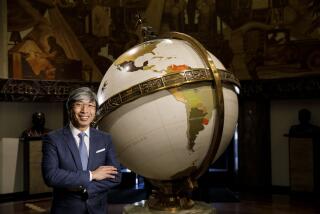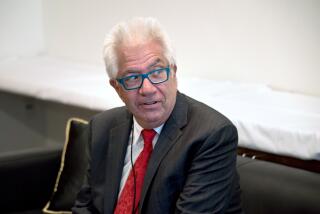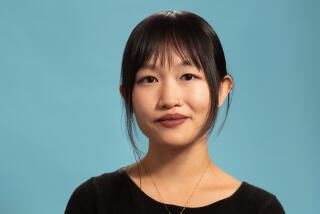A Profile Inspires Both Anger and a Publisher’s Defense
- Share via
I read with a mixture of bemusement and horror your recent profile-Lite of publisher Tom Kagy (“A Place for Their Own Heroes,” April 2). As one of the “eight-person staff” (senior managing editor, Transpacific, 1996) in the “fancy office” obliquely referred to as “gone,” I was stunned to find that this calculating, manipulative anti-publisher had been so lovingly rendered. I saw no mention of the long hours his staff put in. There was, interestingly enough, no mention of the lack of communication between Kagy and his staff.
A particularly galling moment was Kagy’s finely detailed, elegant essay (Issue 65) under the pen name H.Y. Nahm, on the subject of dignity. He contended that Asians held a certain dignity and consideration for others that was foreign to Americans. There is a quickly growing network of disillusioned writers and subscribers who have been taken for a dignified ride by Kagy.
EDDIE RIVERA
Los Angeles
*
Re “A Place for Their Own Heroes”: This standard-brands hardscrabble minority-struggle saga isn’t just another puff piece. It wrongfully exalts the man as something of a minority hero when, in fact, he is anything but. I was managing editor of Face for most of last summer. The most disturbing thing for me about the magazines is the in-house prejudice that has driven editorial policy--a prejudice that was a more complicated twin of the prejudice that Kagy so nobly vows he fights: It was strict policy that Eurasian models were not to be used in photo spreads in Face. The Kagys wanted what they called a “pure” Asian look.
There was also an ethnic code in place that had nothing to do with story merit. People of Korean, Chinese and Japanese descent were portrayed with the most prominence. Vietnamese were a distant fourth in importance while Filipinos, Malaysians, Thais and Cambodians followed, and East Indians and Pacific Islanders were rarely considered.
The ethnic pecking order was reiterated to me by both Tom and Shi Kagy, and was based, they said, on circulation figures. Most of the readership was made up of people of Korean, Chinese and Japanese origin. I was told about it when one too many Vietnamese seeped into an issue.
Among the reasons I quit were the cavalier and insulting attitudes by Tom and Shi Kagy toward the good freelancers I hired and editing policies that defied the language. Recurring themes in both Transpacific and Face are the clubby reappearance of the same people for profile over the years as well as the nauseating vanity coverage of “Star Trek” actor George Takei, an investor in the magazines. Editorial copy often reflected very favorably on advertisers and same-subject stories and ads were planted on the same page.
For a magazine aimed at Asian Americans, none were on its payroll in my three months at Face. The only Asians or Asian Americans I saw in the offices were the Kagys.
Kagy has a mission and believes he’s fulfilling it. But what of the Eurasians who subscribe to Face thinking that the magazine can fill a gap in their experience? Or the Cambodians or Thais who pick up Transpacific at the newsstand?
JERRY ROBERTS
Torrance
*
Tom Kagy replies: Roberts’ accusations of racial prejudice in our editorial policy are especially startling given the fact that during his two months with us, he certainly had occasion to peruse back issues. Eurasian models and subjects have been featured in the pages of both magazines on numerous occasions. In fact, the most popular model ever featured in Transpacific, judging by reader response, was a Eurasian model named Angela Harry who went on to grace the first cover of Face, one of three Eurasian models who have done so during Face’s first 22 issues.
As with any consumer magazine, we strive for a demographic balance in the subjects we cover and picture. Our readership consists of Americans of Chinese (37%), Japanese (19%), Korean (16%), Vietnamese (6%) and Filipino (6%) descent as well as non-Asians. In fact, our use of Vietnamese and Filipino models and profile subjects has exceeded the representation of these ethnicities among our readership. On more than two dozen occasions in our combined 94 issues, we have featured models with no Asian blood.
I doubt Jerry Roberts can point to any consumer medium that is as liberal, open-minded and fair. If the mainstream American media had been as fair when I was growing up, I may have never felt the need to launch magazines like Transpacific and Face.
More to Read
Sign up for our Book Club newsletter
Get the latest news, events and more from the Los Angeles Times Book Club, and help us get L.A. reading and talking.
You may occasionally receive promotional content from the Los Angeles Times.







